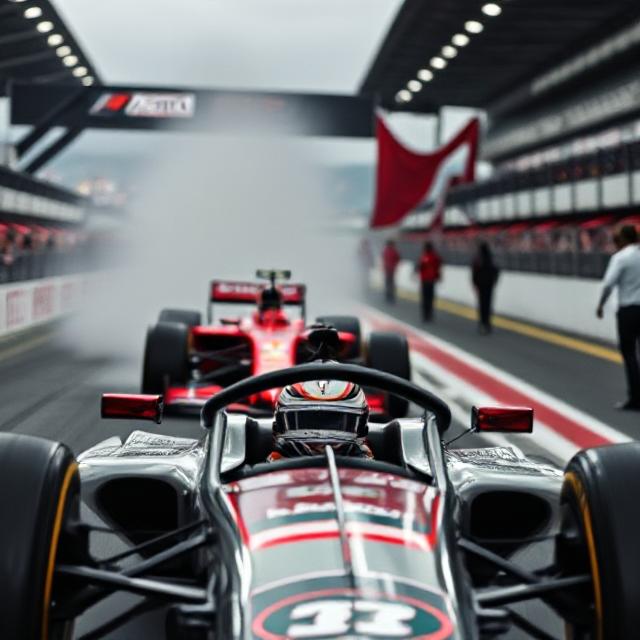“F1 Movie Breakdown: Why This Film Could Redefine Racing Dramas”
The “F1 Movie”, released on June 27, 2025, directed by Joseph Kosinski and starring Brad Pitt, has garnered a lot of buzz as a potential game-changer in the racing drama space. This American sports drama aims to capture the high-stakes, adrenaline-fueled world of Formula 1 racing, while weaving a compelling story around a fictional team, APX GP. Below, we explore why this film could redefine the genre, focusing on its innovative production, authentic immersion, strong performances and widespread cultural impact.
Unprecedented Authenticity Through Real-World Integration of F1 Movie
As the excitement builds around the F1 Movie, audiences are eager to see how it will resonate with both racing fans and film enthusiasts alike.
F1 sets itself apart by embedding its production into the real Formula 1 ecosystem, a feat rarely accomplished in sports cinema. Filming took place during actual Grand Prix weekends in 2023 and 2024, including iconic circuits such as Silverstone, Monza and Abu Dhabi.
Actors Brad Pitt and Damson Idris drove modified Formula 2 cars designed in collaboration with Mercedes-AMG and Carlin Motorsport during actual race weekends that blended seamlessly with the real F1 grid. The use of advanced camera technology, including iPhone-based onboard cameras and Sony’s Venice Extension System, allowed for interior, high-speed scenes that capture the sport’s intensity with unparalleled realism.
Lewis Hamilton’s role as co-producer and consultant ensured technical accuracy, from pit stop dynamics to driver psychology, making the film resonate with fans and newcomers alike. This level of immersion could redefine how racing dramas strike the balance between authenticity and cinematic storytelling.
A Stellar Cast and Compelling Narrative of F1 Movie
The film’s story, centered on Sonny Hayes (Brad Pitt), a retired driver who returns to the struggling APX GP team to mentor rookie Joshua Pierce (Damson Idris), offers a classic underdog tale with a new twist. The cast, including Javier Bardem as team owner Ruben Servants and Kerry Condon as technical director Kate McKenna, bring depth to the interpersonal drama.
Pitt’s charismatic portrayal echoes the ideals of iconic sports films, drawing comparisons to Days of Thunder, yet feels distinct due to its focus on team dynamics and redemption. The rivalry between Hayes and Pearce, with mutual growth, avoids clichés by emphasizing teamwork over individualism.
This character-driven approach, combined with a script that integrates technical F1 jargon, elevates the film above the usual sports dramas, providing emotional depth and relatability that could set a new standard for the genre. Technical Brilliance and Visual Spectacle
Technical Brilliance and Visual Spectacle of F1 Movie
Directed by Joseph Kosinski, best known for Top Gun: Maverick, F1 leverages cutting-edge cinematography to deliver spectacular racing sequences. Using compact, motorized camera mounts, the film captures dynamic shots that take the viewer inside the cockpit, capturing the raw speed and danger of F1.
Hans Zimmer’s pulsating score complements the visuals, enhancing the adrenaline rush. While some critics have noted pacing issues and over-explanatory dialogue, the visual fidelity—filmed on a real track with real F1 personnel—provides an experience unmatched by predecessors like Driven or Days of Thunder.
The film’s technical accomplishments, including the seamless integration of fictional APX GP cars into real race footage, demonstrate a new benchmark for visual storytelling in racing films, potentially influencing future productions to prioritize authenticity and spectacle.
authenticity and spectacle.4. Cultural Impact and Broadening F1’s Appeal
F1 arrives at a time when Formula 1’s global popularity is on the rise, thanks in large part to Netflix’s Drive to Survive. The film capitalizes on this momentum, attracting a wide audience while serving as a two-and-a-half-hour advertisement for the sport.
By featuring cameos from real F1 drivers like Max Verstappen and team principals like Toto Wolf, it bridges the gap between fiction and reality, attracting both hardcore fans and casual viewers. The film’s fictional narrative, while taking liberties, draws inspiration from real F1 events, such as Romain Greatness 2020 crash, which adds relatability.
Its focus on diverse characters like Black British rookie Joshua Pearce reflects F1’s evolving demographics, potentially attracting new fans. By combining Hollywood panache with the rigor of motorsport, F1 could redefine racing dramas as a gateway to mainstream sports entertainment.
Addressing Genre Shortcomings and Future Potential Of F1 movie
While F1 has been criticized for its predictable plot and weak female character development, its strengths lie in avoiding tired tropes like exaggerated rivalries or unrealistic racing mechanics. The film’s emphasis on the technical crew—engineers, mechanics, and strategists—highlights the collaborative nature of F1, which is rare in the genre.
Its box office success and positive Rotten Tomatoes score suggest the possibility of a sequel, which could further explore themes like innovation or diversity in motorsport. By setting a high standard for production values and authenticity, F1 could inspire future racing dramas to prioritize realism and emotional stakes, thereby reshaping the genre.
Share this content:

Post Comment